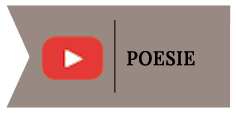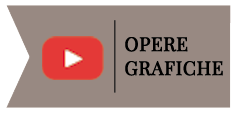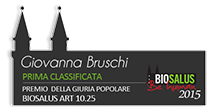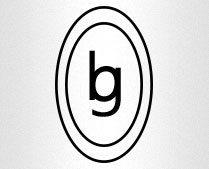Emidio De Albentiis – October 2002
Between nature and art: the spiritual enlightenment of Giovanna Bruschi
It is indeed a rare occasion, in this essentially frenetic and self-absorbed environment in which we have been destined to live, to meet artists capable of constantly pursuing the depths of their own intimate and secluded paths. These artists are thematically detached – not by arrogance, but out of natural conviction – from the noisy and often superficial spotlight and exaggerated one upmanship. As soon as I had the good fortune – thanks to one of those fortunate instances that sometimes further enrich our experience as art lovers – to make my acquaintance with the creative universe and poetry of Giovanna Bruschi from Perugia. This meeting immediately confirmed a fundamental assumption: the special devotion to an art cultivated with passion and coherence since the early years of Bruschi’s academic formation in the 1970s, influenced by the presence of relevant personalities – such as Gerardo Dottori (in his late period as the father of contemporary Umbrian art), Dante Filippucci (painter and writer of rare finesse), and father Diego Donati (an extremely gifted engraver particularly attracted by the spirituality of the Umbrian landscape), all prestigious mentors that allowed Giovanna Bruschi to give life to a very personal hortus conclusus, where to blossom her sensations and the intimate fluttering of her soul, narrated with a series of images pervaded by a spiritual enlightenment, often improvised and sometimes matured by a slow but persistent labor. Over the years, thanks to her particular etching technique in conjunction with a commanding drawing expertise, Bruschi has succeeded in an undertaking – certainly not a simple task – to find a formal language perfectly suitable to her ways of being and to her inner feelings. While reviewing the collection of her engravings and graphic works, I thought of the famous, and often misused, aphorism by of the leading intellectuals of The Enlightenment, Georges-Louis Buffon: “Style is the essence of Man”.
By the same token, everything in the oeuvre of Giovanna Bruschi suggests the profound meaning of her ethical and aesthetic research, within a framework that transcends all her physical surfaces into the realm of spirituality, in a dialectic in which nature and art, tangible matter and impalpable essence continuously exchange roles and meaning. After a long and meditated initial period in which the artist was attracted to botanical subject matter as a biological covering surface, she later moved on to works in which this original starting point was intentionally crossed to release the emotions of her inner soul. This search, still in progress, has been centered on the artist’s increasingly strong conviction to give life to a self-sustaining process or revelation before being shown to others, and consistent with her shy and secluded nature. And it is in this journey that the uniqueness of style has constantly expressed, with great significance, the human and aesthetic values of this very sensitive artist: the different degrees of spatial depth, the careful attention to the chiaroscuro effect, the interpenetration between the density of the solids and the ‘aerial brightness of the empty spaces (sometimes formed by pure light), the alternation and more often the coexistence between naturalistic materiality and symbolic abstraction. These are just some of the main strategies successfully pursued by Giovanna Bruschi who often loves to use circular patterns to signify – with efficient layers of allegory – the visionary qualities of her eye.There is also another aspect that makes the formal language of the Perugian artist surprising: the ability to recall – through her technique and method – the great styles of the past, without losing any of her unquestionable originality. This is because we are not dealing at all with the tendency to constantly refer to other artists (a very fashionable trend in the last two decades), but rather with a profound knowledge of our cultural heritage that leads Bruschi to recall – if the image to be created is appropriate to these examples – the Leonardesque depths, the meticulous attention to detail of Dürer and much of the Nordic engraving tradition, as well as the sinuous and enveloping rhythms of the best Baroque season. As it is therefore evident that we are not looking at some obvious copies of classical models with ancient historical-artistic depth, it is worth pointing out that Giovanna Bruschi clearly belongs to that uncommon group of artists who manage to maintain a perfect control of their styles and idiosyncrasies, always seeking the most effective form of expression to communicate, as it happens in those examples drawn randomly from the masters of all time, present in Beaton Angelico, Renoir or a Picasso.
We cannot conclude these brief notes without a reference to another significant feature of Bruschi’s oeuvre: the ability to move at ease and efficiently both with large formats as well as with very small sizes. In particular, I would like to emphasize the unique penchant of this artist for minute engravings, no bigger than a postage stamp, in some cases even smaller: it often happens that in these tiny fragments Giovanna Bruschi evokes great spatial and luminous vastness, allowing for a dialectical process – in a manner consistent with her spirituality – where the inherent fragility of our human condition coexists with the immeasurable universe that surrounds us, exactly along the same lines of the unforgettable reflections by Blaise Pascal or in the incomparable verses of the Infinite by Giacomo Leopardi. And it is perhaps precisely in this dialectic between the ego and the cosmos that the mystical vein so often present in the art of Giovanna Bruschi acquires meaning: a religious sense of mission, never openly expressed nor imposed on others, but interpreted as a suggestion to look beyond one’s own limitations to seek the light of God, for the believers, or at least that “starry sky” that was able to instill in Immanuel Kant the measure of his own moral law.





